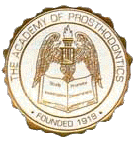Read About the Full History of the Academy of Prosthodontics on the AP History New Website!
History

In 1918, a few distinguished dentists particularly interested in prosthetic dentistry questioned the present status of that phase of dentistry. They sought to learn the extent of differences in the techniques and concepts used in different parts of the country. Furthermore, it was felt that the anatomic, physiologic, and technical facets of prosthetics could and should be correlated, developed, and enlarged.
The National Dental Association meeting of 1918 was held in Chicago, Illinois. Dr. Milus M. House and Dr. I. Lester Furnas were staying at the Congress Hotel. On the evening of August 3,1918, they received a phone call from Dr. George H. Wilson of Cleveland who asked to meet with them and discuss the formation of a prosthetic society. Dr. William A. Giffen, a future president of the National Dental Association, was staying at the hotel and was also invited to attend the meeting. A lively discussion ensued. The following day Drs. Furnas, House, Wilson along with Benjamin F. Thielen, and Alex H. Patterson agreed to personally invite as many interested colleagues as they could contact to gather on August 6th for a mid-day luncheon meeting at the Congress Hotel. Dr. Giffen was absent because of his commitment to the National Dental Association meeting, while 31 of the invited 49 were present. Dr. Dayton D. Campbell was elected Chairman and Dr. Alex H. Patterson, Secretary. Dr. Wilson led a discussion concerning the need for, the purpose of, and the usefulness of the proposed prosthodontic organization. Chairman Campbell appointed a committee to suggest a name and draw up a constitution and bylaws for the new organization.
The group met again on August 9th and the first officers were unanimously named. They were:
Dr. George H. Wilson Honorary President
Dr. William A. Giffen President
Dr. Milus M. House 1st Vice-President
Dr. Alex Patterson 2nd Vice-President
Dr. Dayton D. Campbell Secretary
Dr. Russell W. Tench Treasurer
Drs. George B. Snow and J. Leon Williams were selected as Honorary Members. The two-year Councilmen were Drs. Claude J. Stansbury and William E. Cummer. This group became the first Executive Council. It functioned much the same as today's Executive Council of the Academy of Prosthodontics. Dr. Milus House presented a gavel to the Academy in 1920 that is still in use today.
At the 1922 meeting, the completed Constitution and Bylaws of The National Society of Denture Prosthetists (NSDP) was presented to the membership. It was a concise document that included each committee with related functions described. The programs of the early meetings were composed of essays, discussions, demonstrations, and clinical participation. During that era members came to the place of meeting by train. Many brought their own patients, and most meetings were two weeks long. They began in the early morning, lasted throughout the day, and into the night. In 1923, after a lengthy and heated discussion, it was decided to have an essayist present the subject of removable partial dentures on the following year's program.
As the discipline of prosthodontics was evolving it became apparent that there was a need to establish prosthodontics as a specialty of dentistry and a method to ascertain the level of an individual’s prosthodontic knowledge. Nine Academy Fellows (Drs. Kingery, Hooper, Dresen, McLean, Elliott, Hardy, Stansbury, Boucher, and Tench) were elected to establish the American Board of Prosthodontics. The American Board of Prosthodontics was incorporated in the state of Illinois February 21, 1947. The Academy of Prosthodontics sponsored the Board Examinations for 25 years, a process that further refined the specialty. In 1972, the Academy relinquished sponsorship of the Board to the Federation of Prosthodontic Organizations (FPO) and subsequently upon the dissolution of the FPO at the end of 1994 to the American College of Prosthodontists.
In 1940, the NSDP voted to change the name of the organization to the Academy of Denture Prosthetics (ADP). The action was ratified by the membership, and the name remained the same from 1941 to 1991. The words “study, investigate, promote, and disseminate” were embraced as a succinct mission statement and placed onto the Academy’s seal. Following a long period of deliberation late in the 1980's, the Executive Council of the ADP unanimously recommended that a name change of the organization, to the Academy of Prosthodontics. The name change was proposed to better represent the broad range of treatment provided by prosthodontists.
In 1990, the membership voted to make a Constitutional name change and at the 1991 Annual meeting in Wintergreen, Virginia, the change was subsequently ratified. Members of the Academy are known as Fellows. Categories of Fellowship include Honorary, Life, Active, and Associate. Fellowship is by invitation. Currently, the total membership of all Fellows is 160. The membership is broad-based representing areas of prosthodontic research, education, and clinical practice. Members reside primarily in the United States and Canada, but also in Europe, Asia and Mexico. There is a close professional and social relationship between the Fellows of the Academy, as well as their families. Mentoring for the development of professional leadership and the exchange of educational concepts is prevalent. Dr. Howard S. Payne, a Past-President and Academy Life Fellow, who had the longest continuous membership and attendance of half a century, best exemplifies the commitment to the Academy by its members. The Academy recognized his contributions at the 1999 meeting in Calgary, Alberta, Canada. In 2005, Dr. Payne received the first Academy Distinguished Service Award presented in Scottsdale, Arizona by Past-president Ronald Desjardins.
Annual Meetings are currently four to five days in duration and held in the month of May. Scientific Programs are open to all interested dentists as invited guests of an Academy member or the Executive Council. Scientific Programs consist of scholarly essays with critical analyses or reviewed discussions, poster presentations to encourage new ideas and talents and workshops designed to address impending scientific or educational needs of the dental community. Scientific programs comprise leading-edge technologies and current trends in scientific research. Recent programs have stressed evidence-based dentistry whereby scientific research rigor is applied to clinical dentistry. Essayists are encouraged to submit their paper for publication in the Journal of Prosthetic Dentistry, the official journal of the Academy.
The Academy had been responsible for initiating many prosthodontic documents. The Academy is one of the three organizations that founded the Journal of Prosthetic Dentistry in 1951. The Academy continues to maintain the Glossary of Prosthodontic Terms, which is in its 9th Edition and is accepted worldwide as the leading source of prosthodontic terminology. Other prosthodontic organizations are encouraged to submit new terms and definitions to the Nomenclature Committee for revisions of the Glossary. The Principles, Practices and Concepts in Prosthodontics documents were developed as a consensus-based precept of ideas, methods, and techniques in the clinical practice of prosthodontics and became a valuable parameters of care reference of its time.
The Academy has long recognized the ongoing need to support education, research, and the clinical practice of prosthodontics. As a result, the Educational and Research Foundation of Prosthodontics was founded at the1960 meeting. In 1968, the Academy celebrated its 50th Anniversary in New Orleans, Louisiana with Daniel Gehl as President. The FPO sponsored a National Symposium held at the Mayo Clinic in 1989 addressing current and future aspects of prosthodontic education, research, and education for the 21st century. The Academy of Prosthodontics was essential to its development and implementation. The recommendations, which resulted from that undertaking, are still being acted upon. The Academy of Prosthodontics Foundation superseded the Education and Research Foundation in 1991. The AP Foundation provides grants for educational purposes, outreach projects and to advanced students in prosthodontics at dental schools and teaching hospitals for the conduct of scientific research. Research findings resulting from such grants are usually presented before the Fellowship of the Academy at the Annual Meeting.
Academy Fellows have participated in community service-outreach projects providing prosthodontic care for more than 25 years. Prosthodontic treatment has been provided by Academy Fellows and other interested individuals to native Americans who otherwise could not afford or did not have access to care in remote areas of Alaska, Arizona, the Dakotas, Illinois, Mexico, Montana, Nebraska, New Mexico, Oklahoma, Uganda, Utah, and Wyoming. The White House, in a letter received from President Clinton, as well as the American Dental Association have acknowledged the Academy’s members and outreach programs highlighting these humanitarian efforts.
In 1993, the Academy celebrated its 75th Anniversary in Vancouver, British Columbia with Dr. Brien Lang as President. The Academy revisited its mission, goals and objectives at a special meeting in Crystal City, Virginia in 1995. New goals were identified, which included maintaining and improving recognition for the scientific program, facilitating and nurturing leadership, achieve acknowledgement for the outreach-community service program, impacting the manner in which prosthodontic service is delivered to the public, and providing the opportunity for the introduction of innovative technology with the provision of adequate resources to achieve these goals. Academy fellows Sree Koka and Neal Garrett along with Academy faculty developed the ongoing Future Leaders in Prosthodontic programs to identify young prosthodontists and further their leadership skills development.
In 2018, the Academy celebrated at its Centennial Anniversary in Chicago, Illinois with Dr. James Taylor as President. Invited editorials were published in the JPD that focused on the various professional contributions of the Academy. An Academy of Prosthodontic s textbook with illustrations was published in 2019 that highlighted the 100 years of fellowship and scholarship. Subsequently, a website was created in 2021 that elaborates upon the history of the Academy of Prosthodontics and its fellowship at APHistory.net
The Academy continues to grow steadily by attracting young prosthodontists who understand and embrace its mission and, in the process, expand and share their knowledge for the betterment of the Academy, its fellows and the dental community. The Academy of Prosthodontics remains the oldest prosthodontic organization in existence to advance prosthodontic education, research and clinical practice.
Visit the APHistory.net website, created by the AP History and Records Committee, created under the leadership of Dr. Jonathan Wiens, to preserve the important history of the Academy of Prosthodontics.
